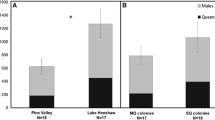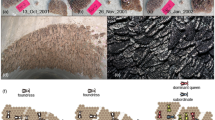Summary
We observed in the field how resident females of the social wasp, Polistes fuscatus, treated female nestmates, non-nestmate first cousins, and unrelated non-nestmates. Behavioral observations were made 1, 3, 4, 6, 7, 8, and 11 weeks after the emergence of a colony's first workers. Resident females were highly tolerant of female nestmates but highly intolerant of unrelated non-nestmates throughout the post-worker-emergence phase of the colony cycle. First cousins were treated either highly tolerantly or highly intolerantly, although most cousins (∼ 63%) were treated highly intolerantly. The treatment of cousins suggests that they are treated either tolerantly (like nestmates) or intolerantly (like unrelated non-nestmates) depending on whether they fall above or below an acceptance threshold, respectively. Resident females did not significantly change their tolerance nestmates, first cousins, and unrelated females between different observation periods. However, all conspecifics were generally treated the most intolerantly 11 weeks post-worker-emergence, a time in the colony cycle when combs no longer contain brood. This decreased tolerance and its associated variance patterns late in the colony cycle are consistent with a more restrictive acceptance threshold. The optimal level of the acceptance threshold appears to be a compromise between the fitness consequences of accepting unrelated non-nestmates and rejecting one's nestmates. In a laboratory study, resident females were equally tolerant of female nestmates on and off the comb but significantly less tolerant of unrelated females on the comb than off the comb. Thus, females can modify their tolerance rapidly in different recognition contexts. In a second laboratory study, resident females were equally intolerant of unrelated females, regardless of whether they were from colonies 50 m or 50 km distant.
Similar content being viewed by others
References
Davis SK, Strassmann JE, Hughes C, Pletscher LS, Templeton AR (1990) Population structure and kinship in Polistes (Hymenoptera, Vespidae): an analysis using ribosomal DNA and protein electrophoresis. Evolution 44:1242–1253
Gamboa GJ (1978) Intraspecific defense: advantage of social cooperation among paper wasp foundresses. Science 199:1463–1465
Gamboa GJ (1988) Sister, aunt-niece, and cousin recognition by social wasps. Behav Gen 18:409–423
Gamboa GJ, Heacock BD, Wiltjer SL (1978) Division of labor and subordinate longevity in foundress associations of the paper wasp, Polistes metricus (Hymenoptera: Vespidae). J Kansas Entomol Soc 51:343–352
Gamboa GJ, Reeve HK, Ferguson ID, Wacker TL (1986a) Nestmate recognition in social wasps: the origin and acquisition of recognition odours. Anim Behav 34:685–695
Gamboa GJ, Reeve HK, Pfennig DW (1986b) The evolution and ontogeny of nestmate recognition in social wasps. Annu Rev Entomol 31:431–454
Gamboa GJ, Klahn JE, Parman AO, Ryan RE (1987) Discrimination between nesimate and non-nestmate kin by social wasps (Polistes fuscatus, Hymenoptera: Vespidae). Behav Ecol Sociobiol 21:125–128
Gamboa GJ, Reeve HK, Holmes WG (1991) Conceptual issues and methodology in kin recognition research: a critical discussion. Ethology (in press)
Grafen A (1990) Do animals really recognize kin? Anim Behav 39:42–54
Holmes WG (1988) Kinship and the development of social preference. In: Blass EM (ed) Handbook of behavioral neurobiology, vol 9. Developmental psychobiology and behavioral ecology. Plenum Press, New York, pp 389–413
Kasuya E, Hibino Y, Itô Y (1980) On “intercolonial” cannibalism in Japanese paper wasps, Polistes chinensis antennalis Perez and P. jadwigae Dalla Torre (Hymenoptera: Vespidae). Res Popul Ecol (Kyoto) 22:225–262
Klahn JE (1979) Philopatric and non-philopatric foundress associations in the social wasp Polistes fuscatus. Behav Ecol Sociobiol 5:417–424
Khahn JE (1981) Alternative reproductive tactics of single foundresses of a social wasp, Polistes fuscatus. PhD dissertation, University of Iowa
Klahn JE (1988) Intraspecific comb usurpation in the social wasp Polistes fuscatus. Behav Ecol Sociobiol 23:1–8
Linsenmair KE (1985) Individual and family recognition in subsocial arthropods, in particular in the desert isopod Hemilepistus reaumuri. In: Hölldobler B, Lindauer M (eds) Experimental behavioral ecology and sociobiology. Sinauer, Sutherland, pp 411–436
Linsenmair KE (1987) Kin recognition in subsocial arthropods, in particular in the desert isopod Hemilepistus reaumuri. In: Fletcher DJC, Michener CD (eds) Kin recognition in animals. Wiley, New York, pp 121–208
Metcalf RA, Whitt GS (1977) Intranest relatedness in the social wasp Polistes metricus. Behav Ecol Sociobiol 2:339–351
Noonan KM (1979) Individual strategies of inclusive fitness maximizing in the social wasp, Polistes fuscatus (Hymenoptera: Vespidae). PhD dissertation, University of Michigan
Noonan KM (1981) Individual strategies of inclusive fitness maximizing in Polistes fuscatus foundresses. In: Alexander RD, Tinkle DW (eds) Natural selection and social behavior: research and theory. Chiron Press, New York, pp 18–44
Pfennig DW (1990) “Kin recognition” among spadefoot toad tadpoles: a side-effect of habitat selection? Evolution 44:785–798
Pfennig DW, Gamboa GJ, Reeve HK, Shellman-Reeve J, Ferguson ID (1983a) The mechanism of nestmate discrimination in social wasps (Polistes, Hymenoptera: Vespidae). Behav Ecol Sociobiol 13:299–305
Pfennig DW, Reeve HK, Shellman JS (1983b) Learned component of nestmate discrimination in workers of a social wasp, Polistes fuscatus (Hymenoptera: Vespidae). Anim Behav 31:412–416
Reeve HK (1989) The evolution of conspecific acceptance thresholds. Am Nat 133:407–435
Reeve HK (1991) Polistes. In: Ross KG, Matthews RW (eds) The social biology of wasps. Cornell University Press, Ithaca (in press)
Shellman JS, Gamboa GJ (1982) Nestmate discrimination in social wasps. Behav Ecol Sociobiol 11:51–53
Waldman B (1987) Mechanisms of kin recognition. J Theor Biol 128:159–185
West Eberhard MJ (1969) The social biology of Polistine wasps. Misc Publ Mus Zool Univ Mich 140:1–101
Author information
Authors and Affiliations
Additional information
Offprint requests to: G.J. Gamboa
Rights and permissions
About this article
Cite this article
Gamboa, G.J., Foster, R.L., Scope, J.A. et al. Effects of stage of colony cycle, context, and intercolony distance on conspecific tolerance by paper wasps (Polistes fuscatus). Behav Ecol Sociobiol 29, 87–94 (1991). https://doi.org/10.1007/BF00166482
Received:
Accepted:
Issue Date:
DOI: https://doi.org/10.1007/BF00166482




